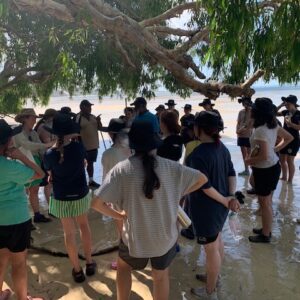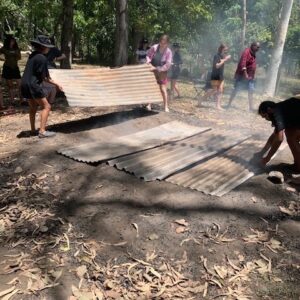
Cape York Conversations
We hope you are enjoying reading the range of reflections about Cape York experiences from the students this week, for previous weeks see here.
Reflections
In the holidays a group of SCEGGS girls had the opportunity to attend an immersion to Cape York. After being selected to attend the trip, I was both excited and curious about travelling to an Aboriginal homeland and immersing myself in unfamiliar and new experiences. We travelled to two different homelands, each providing a richness of knowledge and stories that will continue to stay with me.

We were fortunate enough to explore the beauty and history of Indigenous land, walking up mountains and swimming in rivers that had great cultural significance. This was told through the stories by the Traditional Owners of the land and they expressed how important it is that these stories are shared, as it increases the Indigenous culture that must be kept alive.
We had the opportunity to try new foods and to learn parts of different Indigenous languages and familial structures. This cultural immersion was life changing and I hope that many more people receive the opportunity to experience this trip in the future and to pass on the rich history of Indigenous culture.
Paris Venetoulis
Year 10
Coming home from the Cape York immersion trip I have been able to reflect on the abundance of rich knowledge and connection to country I am honoured to have experienced in the two homelands I visited: Thithar-warra and Bana. The Traditional Owners of each homeland were incredibly open-hearted in welcoming us into their lives and providing us opportunities to learn from them throughout our stays. Leading up to the immersion, I had anticipated that this trip would be meaningful and is not something you come across too often but was completely unaware of the impacts it would have on me. I truly believe this immersion has changed my life for the better. Reading back through the journal I kept throughout the trip, I am able to relive the life-long memories of learning about tens of thousands of years of history and culture from the Traditional Owners through the walks along the beach or down to the creek, cooking a traditional kup murri, and the thought-provoking chats around the campfire at night.
I have found greater appreciation and admiration for the diverse land we live on and its flora and fauna, and the immense understanding Aboriginal and Torres Strait Islander People have of it. One major takeaway from this experience for me would be talking to a Traditional Owner from the first homeland, Thithar-warra, Rob, about the power of education and knowledge. The power education has in our society, in giving us opportunities to be able to connect and learn from one another. Coming back home, I want to share the lessons and stories that were shared with us with others, and also hope to learn from the Indigenous peoples of where I call home and where SCEGGS is built, the Gadigal people of the Eora nation.
Frida Radford
Year 10
I feel extremely privileged to have spent ten memorable days with friends (new and old) in the beautiful Melsonby and Panamuunji homeland. During my stay, I was fortunate to have learned the deep history and culture of the traditional owners and experience their relaxed and simple way of life. I am so grateful that I kept a detailed journal record of my experience which has helped me to relive memories and share my new learnings with others.
Some of my favourite moments of my immersion include painting our bodies with ochre while sitting on the edge of the shallow creek, bonding with the children on the land as we drew pictures together in my journal, sleeping under a bed of stars that covered the night sky and visiting a rock site to explore ochre prints that symbolised the rich and confronting history of colonisation. I will forever remember snorkelling with friends at the iconic Great Barrier Reef and exchanging our life-changing experiences from the homelands.
The opportunity to escape my busy Sydney life helped me to realise the importance of relaxation. I enjoyed the peacefulness that came from being among nature – without the usual distraction of technology. The unfamiliar environment also allowed me to step out of my comfort zone and make meaningful connections with people that I wouldn’t ordinarily interact with, including peers from other years, Traditional Owners, and teachers.
I know that the learnings from my immersion experience will stay with me forever. I now have a deeper understanding of Australian history from the perspective of our First Nations People that could not have come from the classroom or a textbook. The connections that I made on the trip are long lasting and life changing. To anyone that is considering a Red Earth adventure in the future, my advice is to go for it! It’s an experience like no other and one that you definitely won’t regret.
Zara O’Shea
Year 10
Going on the Cape York trip was one of the best decisions I’ve ever made. It can be difficult to push yourself out of your comfort zone, but in this case, it paid off. I, along with the other girls who were in my Yellow Group, learnt so much from the Traditional Owners in regards to their cultures, languages, lifestyles, and opinions on political matters.
Something that stood out to me most was the Kup Murri that we had on our second homelands, the Bana homelands. The Kup Murri is a sacred cooking ritual that is performed only on special occasions, such as birthdays and funerals, so the fact that it was shared with us was an immense honour. A Kup Murri is an underground oven where food such as chicken, yams, and potatoes are cooked over a long period of time. Whilst the oven was being prepared (hot coals were being made), people cut up the vegetables, seasoned the chicken, and wrapped all of the food in foil packages. These were then placed on a wire mat, covered in rocks, bottle brush, and banana leaves, and lowered into the oven. Then pieces of corrugated iron were placed to cover the food. To further trap the heat in, dirt and rocks were placed atop the iron in spots where smoke/steam were coming out. Below is a nicer version of the diagram I drew when on the trip, so you can really visualise the structure.

When the food was ready, we got together and ate it with the Traditional Owners, and it was absolutely delicious! Being a part of such a special tradition of the Bana culture was an honour for us all, and I’m glad to be sharing it with the SCEGGS community, too. When talking with one of the Traditional Owners, Molly, we noted how underground ovens are a part of many traditional foods across the world, such as in Turkey, Polynesia and Morrocco. It’s incredibly fascinating how across the globe, cultures so different from one another can share things.
This Kup Murri experience was an absolute highlight for all of us in the Yellow Group, and I’m so proud to be able to share it with you all.
Leyla Bensan
Year 10

















